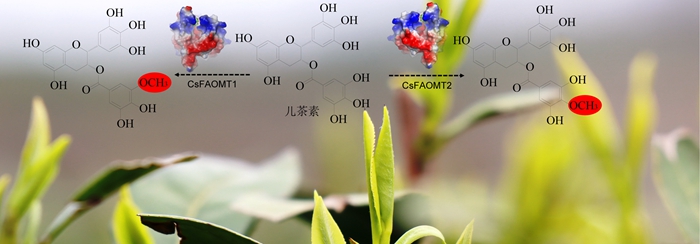Discovery Unveils Biosynthesis Mechanism of O -methylated Catechins in Tea Plants
The Tea Germplasm Resource Innovation Team of the Tea Research Institute of the Chinese Academy of Agricultural Sciences, in collaboration with relevant scientific research teams from domestic universities, has revealed the biosynthesis mechanism of O -methylated catechin derivatives in tea plants, laying a theoretical foundation for cultivating new tea cultivars with more distinctive functional components. Results of the study have been recently published in Nature Communications .

Catechins, constituting over 12% of tea’s dry weight, have been extensively studied for their significant physiological activities such as anti-aging and anti-cancer effects. However, due to their highly polar nature and instability in the neutral to basic conditions of the intestine, their bioavailability in the human body is relatively low. O -methylated catechins are a series of derivatives formed by the O -methylation modification of catechins, and they exhibit higher stability and bioavailability compared to normal catechins. Numerous studies have shown that O -methylated catechins have significant physiological effects, including anti-allergic, antihypertensive, and regulation of intestinal microbiota, etc. However, the key O -methyltransferases responsible for catalyzing the biosynthesis of O -methylated catechins has not yet been identified.

To address this issue, the research team constructed a genetic segregation population and employed multiple omics technologies to discover and identify two key enzymes, elucidating the molecular mechanism underlying the formation of high O -methylated catechin traits in tea plants. Additionally, the successful resolution of the protein crystal structures of these two enzymes revealed the crucial amino acids required for catechin O -methylation. This research provides a theoretical basis for the efficient utilization of tea plant resources and the cultivation of high O -methylated catechin cultivars, while also offering insights and reference cases for unraveling the formation of other important economic traits of tea plants.
The study was supported by the National Natural Science Foundation of China and the Chinese Academy of Agricultural Sciences through the Agricultural Science and Technology Innovation Program.
For further details, refer to the original article published at:
https://doi.org/10.1038/s41467-023-40868-9
By Prof. Dr. Ji-qiang Jin (xyjjq@tricaas.com)
-
 Apr 18, 2024Opening Ceremony of the Training Workshop on Wheat Head Scab Resistance Breeding and Pest Control in Africa Held in CAAS
Apr 18, 2024Opening Ceremony of the Training Workshop on Wheat Head Scab Resistance Breeding and Pest Control in Africa Held in CAAS -
 Apr 03, 2024IPPCAAS Co-organized the Training Workshop on Management and Application of Biopesticides in Nepal
Apr 03, 2024IPPCAAS Co-organized the Training Workshop on Management and Application of Biopesticides in Nepal -
 Mar 28, 2024Delegation from the School of Agriculture and Food Science of University College Dublin, Ireland Visit to IAS, CAAS
Mar 28, 2024Delegation from the School of Agriculture and Food Science of University College Dublin, Ireland Visit to IAS, CAAS -
 Mar 25, 2024Director of World Food Prize Foundation visited GSCAAS
Mar 25, 2024Director of World Food Prize Foundation visited GSCAAS -
 Mar 20, 2024Institute of Crop Sciences (ICS) and Syngenta Group Global Seeds Advance Collaborative Research in the Seed Industry
Mar 20, 2024Institute of Crop Sciences (ICS) and Syngenta Group Global Seeds Advance Collaborative Research in the Seed Industry
